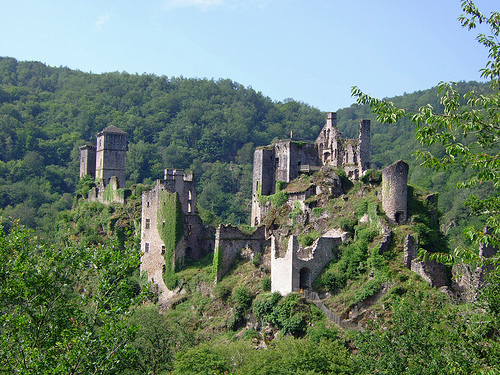

Towers of Merle is a complex of defensive structures situated in the French wilderness.
Location: Saint-Geniez-ô-Merle, Corrèze département Map
Constructed: 12th and 15th century
Official site
The medieval remains of the Tours de Merle stand on a steep rocky outcrop, in a meander of the Maronne, in the heart of Xaintrie, in the French department of Corrèze in the commune of Saint-Geniez-ô-Merle. The visitable site includes a 10 hectare park.
From the beginning, the site bears the name of blackbird which could
refer to the bird, naturally present, or to the merlon, the solid part
of a parapet located between two battlements according to the
architectural term.
Fortified largely naturally, the site offers
the lords a dominant position because it is built on a rocky outcrop 30
meters high, 40 meters wide and 200 meters long, in a meander of the
Maronne river. The first mention of the site dates back to 1219 (an
eponymous family is attested from the end of the 11th century) and the
castrum lasted until the 16th century.
Place of toll, the castrum
is located on the border between the Duchy of Aquitaine, the county of
Auvergne and the county of Toulouse and two dioceses. Seven families of
lords cohabit or succeed each other in Merle and several square towers
are erected on the same site in order to prevent each family from
dispersing and weakening. On this “peninsula” the lords of Merle,
Veyrac, Pesteils, Carbonnières (the most eminent), Noailles, Saint
Bauzile and Alboy settled.
From the 12th to the 15th century, the
seigniorial lineages who owned the place built towers, hostels and
walls, thus constituting a castrum which would only decline with the
advent of artillery because the site could easily be bombarded from the
surrounding heights. In 1350, the castrum was home to more than a
hundred peasants and nobles in a village made up of around thirty
thatched cottages with their gardens and orchards. Each social category
is represented since there are lumberjacks, craftsmen, peasants,
priests, lawyers. In the 14th century, Merle comprised seven fortified
houses, two chapels, one of which was dedicated to Saint Léger, and a
village, jointly owned by seven lords of the families of Merle,
Carbonnières, Veyrac and Pestels.
In 1371, during the Hundred
Years War, the English, present since 1357 in the Auvergne and Limousin
basins of the Dordogne, besieged Merle and occupied it: they took a
tower and a castle, which they then restored. In 1475, at the end of the
Hundred Years War, a period of peace contributed to the emergence of an
era of prosperity for the city. The Wars of Religion later cause
murderous ravages when the Protestants take the place and install a
garrison there in 1574; they were chased out two years later by the
co-seigneurs.
However, the site was then abandoned by the
co-lords who preferred to live in more pleasant and accessible places.
At the end of the 17th century, the village population, no longer able
to count on their protection, dispersed and the castellany gradually
fell into oblivion, although inhabitants occupied the village at the
foot of the rock until the beginning of the 20th century.
The
noble families
Merle family
The Merle family is probably at the
origin of the aristocratic core of the site. Following partitions, the
Merles formed several branches, at least three, which shared the rights
to the castrum.
By marriage, the families of Pesteils, Veyrac,
Saint-Bauzille and the Rochedragons entered the co-seigneury. Merle's
family seems to end up submitting to that of Carbonnières. As co-lords
of Merle, they received occasional tributes throughout the Middle Ages,
notably from the Veilhan family.
Pesteil family
Probably originating from Cantal, the Pestels
family would have established itself on the site of Merle at the
beginning of the 13th century, following the marriage of Aymeric de
Pesteil with Hélis de Merle. In 1270, the Pesteils paid homage to the
Carbonnières; this tribute was repeated in 1347.
Merle was the chief town of a castellany; it is not a simple castle,
the site, which indeed integrates several castles, is characterized by
the presence of many co-lords within a specific feudal organization
between lords and villagers in the form of taxes and tributes, hence its
name Castrum de Merle.
There are only vestiges of the castrum, a
collection of fortified houses, towers, walls dating from the 14th
century or earlier. On the site are located.
the ruined piles of the
bridge guard's house;
the location of the Veilhan drawbridge;
the
Noailles tower;
the towers of Pesteils (or Pestel);
the house of
Fulcon de Merle (attested in 1365);
the house of Pierre de Merle;
the house of Hugues de Merle;
the Cofolenc house;
the location of
the so-called Veilhan house;
the location of the second chapel built
in 1674;
the remains of the tower of the Commander of Saint-Léger;
the remains of the fort of St-Basile;
the remains of the castle of
Carbonnière.
Protection
The castral site is the subject of a
classification as historical monuments by decree of July 30, 1927.
Merle's tricks in literature and art
The site serves as the
setting for the historical novel by Louis-Olivier Vitté Guinotte et le
chevalier, whose plot takes place in the 12th century, and also as part
of volume 3 of the fantasy series Louis le Galoup by Jean-Luc Marcastel,
Le Master of the Tours de Merle, whose plot takes place in a different
Middle Ages.